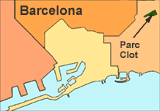Parc Clot
Location: Parc Clot is in an old industrial neighborhood in the Sant Martí district of northeast Barcelona, a short walk from the Plaça des Glôries Catalanes and its famous flea market. It is about 10 acres in size, with picturesque ruins of former factories and both sunken and elevated gardens.
History: Parc Clot was built in 1986 on the site of several abandoned factories. The project was part of a large urban renewal program launched in 1980 that transformed many of Barcelona's abandoned and vacant spaces into plazas, squares, gardens and parks, many featuring works by prominent sculptors. The park has helped revitalized what is now a mixed-income neighborhood.
Physical context: Oriol Bohigas, who was in charge of urban planning for the city between 1980 and 1984, oversaw the development of Parc Clot. "A city is not only the sum of its architecture; it is also an array of parks, boulevards, promenades, and gardens where life unfolds," Bohigas wrote at the time.
|
|
 Back to Barcelona story Back to Barcelona story

The parks built in this era have a consistent design theme: They include paved areas and areas of softer material -- grass, trees and berm -- in equal proportion. In the case of Parc Clot, the mix also includes the steel columns and brick arches of a ruined factory, which serve as a picturesque setting for a bronze sculpture by Brian Hunt. Elements of the 19th century coexist with modern light towers and new green grids.
Although the abandoned buildings originally on the site were torn down, their arched colonnades were kept and arranged with an artificial waterfall to evoke a Roman aqueduct. Other remnants of the buildings, such as an old brick chimney, were also retained. The park was conceived as a multi-functional space, with a low proportion of greenery, artificial hills and valleys, and well-lighted bridges and walkways. It supports a wide variety of recreational and civic uses.
|
|
The design of the park overlays two geometric patterns: one formed by the trees, the other formed by the pathways. There is significant interplay between the hard surfaces and the soft areas of grass and plantings.
Architect: Daniel Freixas and Vicente Miranda.
Lessons learned: In contrast to The Ramblas, Parc Clot is a place without well-defined visual edges. Rather, the juxtaposition of layers emphasizes the diverse textures and materials that intersect on the site. It is an example of how a small-scale park helped bring life back to an abandoned and decaying neighborhood and established new relationships between residents and the area's public space.
This case study was compiled by MIT researchers Alex-Ricardo Jimenez and Zhan Guo, under the direction of Thomas Piper of the Dept. of Urban Studies and Planning.
|



